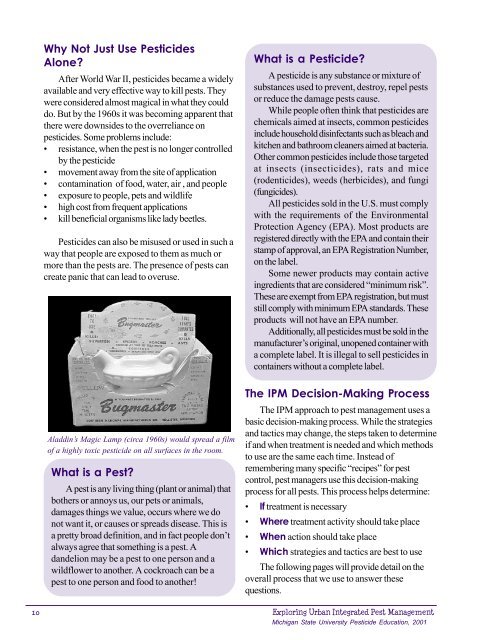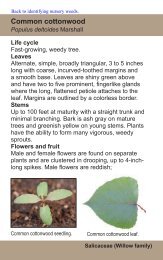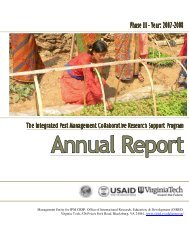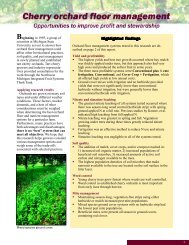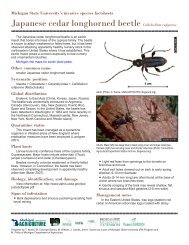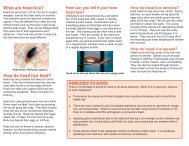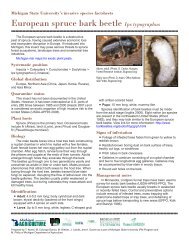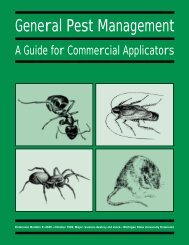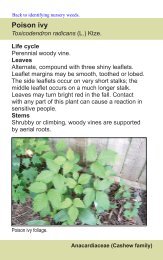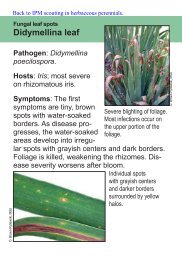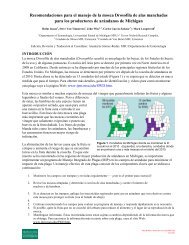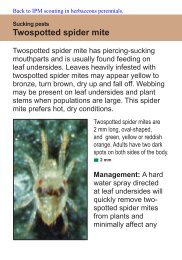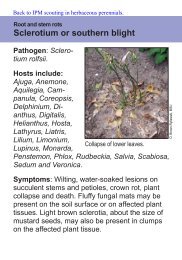Activities and Resources for Teaching K-6 - School Integrated Pest ...
Activities and Resources for Teaching K-6 - School Integrated Pest ...
Activities and Resources for Teaching K-6 - School Integrated Pest ...
You also want an ePaper? Increase the reach of your titles
YUMPU automatically turns print PDFs into web optimized ePapers that Google loves.
Why Not Just Use <strong>Pest</strong>icides<br />
Alone?<br />
After World War II, pesticides became a widely<br />
available <strong>and</strong> very effective way to kill pests. They<br />
were considered almost magical in what they could<br />
do. But by the 1960s it was becoming apparent that<br />
there were downsides to the overreliance on<br />
pesticides. Some problems include:<br />
• resistance, when the pest is no longer controlled<br />
by the pesticide<br />
• movement away from the site of application<br />
• contamination of food, water, air , <strong>and</strong> people<br />
• exposure to people, pets <strong>and</strong> wildlife<br />
• high cost from frequent applications<br />
• kill beneficial organisms like lady beetles.<br />
<strong>Pest</strong>icides can also be misused or used in such a<br />
way that people are exposed to them as much or<br />
more than the pests are. The presence of pests can<br />
create panic that can lead to overuse.<br />
Aladdin’s Magic Lamp (circa 1960s) would spread a film<br />
of a highly toxic pesticide on all surfaces in the room.<br />
What is a <strong>Pest</strong>?<br />
A pest is any living thing (plant or animal) that<br />
bothers or annoys us, our pets or animals,<br />
damages things we value, occurs where we do<br />
not want it, or causes or spreads disease. This is<br />
a pretty broad definition, <strong>and</strong> in fact people don’t<br />
always agree that something is a pest. A<br />
d<strong>and</strong>elion may be a pest to one person <strong>and</strong> a<br />
wildflower to another. A cockroach can be a<br />
pest to one person <strong>and</strong> food to another!<br />
What is a <strong>Pest</strong>icide?<br />
A pesticide is any substance or mixture of<br />
substances used to prevent, destroy, repel pests<br />
or reduce the damage pests cause.<br />
While people often think that pesticides are<br />
chemicals aimed at insects, common pesticides<br />
include household disinfectants such as bleach <strong>and</strong><br />
kitchen <strong>and</strong> bathroom cleaners aimed at bacteria.<br />
Other common pesticides include those targeted<br />
at insects (insecticides), rats <strong>and</strong> mice<br />
(rodenticides), weeds (herbicides), <strong>and</strong> fungi<br />
(fungicides).<br />
All pesticides sold in the U.S. must comply<br />
with the requirements of the Environmental<br />
Protection Agency (EPA). Most products are<br />
registered directly with the EPA <strong>and</strong> contain their<br />
stamp of approval, an EPA Registration Number,<br />
on the label.<br />
Some newer products may contain active<br />
ingredients that are considered “minimum risk”.<br />
These are exempt from EPA registration, but must<br />
still comply with minimum EPA st<strong>and</strong>ards. These<br />
products will not have an EPA number.<br />
Additionally, all pesticides must be sold in the<br />
manufacturer’s original, unopened container with<br />
a complete label. It is illegal to sell pesticides in<br />
containers without a complete label.<br />
The IPM Decision-Making Process<br />
The IPM approach to pest management uses a<br />
basic decision-making process. While the strategies<br />
<strong>and</strong> tactics may change, the steps taken to determine<br />
if <strong>and</strong> when treatment is needed <strong>and</strong> which methods<br />
to use are the same each time. Instead of<br />
remembering many specific “recipes” <strong>for</strong> pest<br />
control, pest managers use this decision-making<br />
process <strong>for</strong> all pests. This process helps determine:<br />
• If treatment is necessary<br />
• Where treatment activity should take place<br />
• When action should take place<br />
• Which strategies <strong>and</strong> tactics are best to use<br />
The following pages will provide detail on the<br />
overall process that we use to answer these<br />
questions.<br />
10 Exploring Urban <strong>Integrated</strong> <strong>Pest</strong> Management<br />
Michigan State University <strong>Pest</strong>icide Education, 2001


